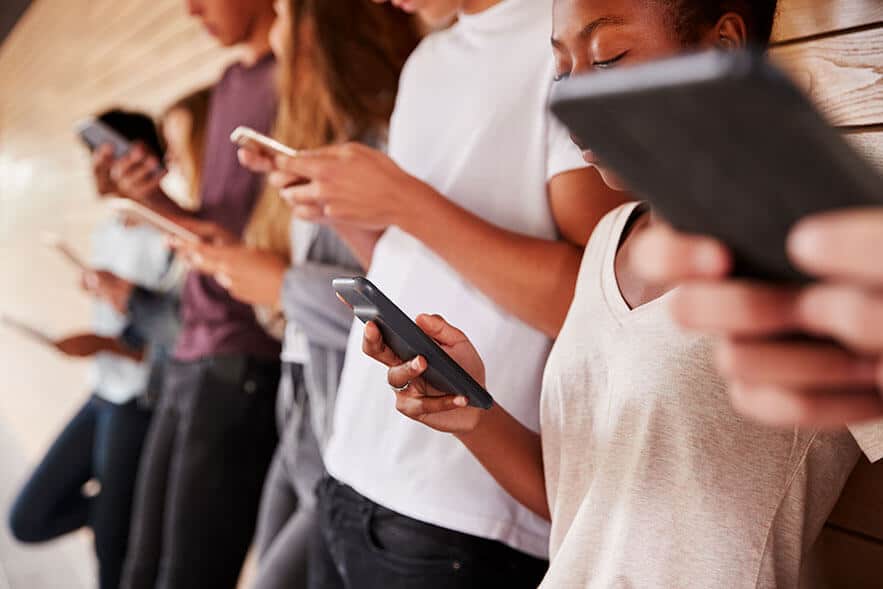In this unique interview with Youth Time, experts of communication discuss the biggest benefit and the biggest downfall of many online communication opportunities, if/to what extent online communication is having an impact on causing misunderstanding among us, why this form of communicating is becoming more and more common, and how the advance of technology (i.e. online communication) intensifies the existing state and form of misunderstanding between people in various capacities of communicating.
How good is your (online) communication?
Discover your online communication: People have found ways to communicate since the very beginning of time. The human race has constantly developed new forms of conveying messages from one person to another.
Mutually understood symbols, signs or a set of specific rules have connected people within a common space of language, understandable and acceptable to all. Nevertheless, with communication comes also the possibility of misunderstanding.
The relevant discussion on the flaws of online communication
Nowadays, most of our interactions are made possible through online platforms and social media. We communicate with work colleagues, with family, as well as with friends through email, Facebook, or other common social media platforms.
Personally, I am not one of those who express themselves much through social media (nothing wrong with that). However, I have been criticized for this and misunderstood more than once.
In the beginning of this article, I am emphasizing that I appreciate all this real-time communication. I was once in a long-distance relationship, and I understand all the benefits stemming from social media. Yet, on the other hand, I find it important to discuss and understand its flaws.
Saying something through text messages is a lot different from saying it in person. The latter lacks the body language, the eye contact, and the emotional connection in the face-to-face moment.
Experts of communication in this article speak to Youth Time to describe if/to what extent online communication is having an impact on causing misunderstanding among us, why this form of communicating is becoming more and more common, how the advance of technology (i.e. online communication) intensifies the existing state and form of misunderstanding between people in various capacities of communicating.
In addition to this, this article will shed some light on the biggest benefit and the biggest downfall of many online communication opportunities, and the differences between online communication and face-to-face communication.
Many misunderstandings that occur online are very similar to those that happen face-to-face
Renee Edwards, PhD, Professor, Department of Communication Studies, Louisiana State University initially explains that misunderstanding and miscommunication occur in all forms of interaction.
“It is actually impossible to have perfect understanding, because each person enters a conversation with different experiences, backgrounds, values, and personalities. We communicate with other people using language and nonverbal behaviors or gestures (including emojis).

A person who receives a message must decode or interpret meaning from the message in light of their own background, which will always be different from that of the person who created the message. This process can get even more complicated in online communication such as email and text messaging, because features such as vocal intonation, facial expression, and hand gestures are not available.
In our studies, participants report that misunderstanding is much more common in computer-mediated communication (CMC) than in face-to-face (FTF) communication.” she states.
Taking into account that Edwards’s interest is Message Interpretation and Misunderstanding in Interpersonal Communication, including the factors that influence the ways that individuals interpret messages and the consequences of misunderstanding and Risk Communication, she further elaborates on how all these above-mentioned factors are impacted by today’s technological advances.
“Although CMC misunderstandings are more common than FTF misunderstandings, our research suggests that they are not as serious. Their effects or consequences on relationships are not as negative. Why?
One reason could be that people realize that CMC is a more limited form of communication, and therefore they have lower expectations for it. Another possibility is that people use CMC (especially text messaging) for less important topics, so any misunderstandings that occur are less serious.”
“the tone or relational meaning is the basis of the misunderstanding”
Responding to Youth Time’s question about how people tend to interpret the online messages they receive, she notes as follows:
“Interestingly, many misunderstandings that occur online are very similar to those that happen face-to-face. They can be about the content or surface meaning of what a person says. For example, to say “see you at 9” could mean (at least in the U.S.) 9:00 in the morning or 9:00 in the evening.
A single message can have two “content” meanings. Misunderstandings can also be about the tone or relational meaning of a message. Our participants report that a text message of “k” or “ok” is thought to be rude or dismissive when it was not intended to carry that emotional meaning.
Maybe the sender was at work and just too busy to send a longer acknowledgement. In this case, the tone or relational meaning is the basis of the misunderstanding.”
Edwards shares with Youth Time why online communication is becoming more and more common and preferable for some people (i.e. young adults).
“Being able to see a situation from the vantage of another person is called perspective-taking. Our research has shown that it can help humanize the communication process that occurs with misunderstandings.
Perspective-taking is the idea that some individuals are more likely to look at every side of a disagreement or imagine how someone else would feel in a situation.
Individuals who do so are less likely to have misunderstandings and have more positive communication following those that occur. It is also valuable for parties to communicate perspective-taking by saying things like “I see what you are saying” when a misunderstanding occurs.”
When we are face-to-face, we barely take time to think about what we say. But, in online communication, we tend to take a step back and refine our words
Gentianë Paçarizi, teaching assistant at the University of Prishtina “Hasan Prishtina”, Department of Journalism, media and information literacy consultant, is of the opinion that technology advances haven’t really intensified the pre-existing stage and form of misunderstanding among people.

“I belong to the group of people who don’t tend to blame technology for the extent of misunderstanding among people. While it is true that technology developments have changed communication at large, to some extent, the lack of understanding (decoding) of a certain message from a sender to a receiver depends more on the shared system of codes people operate with.
People are quick to pick communication codes when the system alters, thus the online landscape has been there long enough for people to become familiar with it. This means that if we want to foster understanding among each other, we have to put more effort into ensuring that the person we’re speaking to shares the same codes as we do or vice-versa.” Paçarizi says.
“we tend to create an echo-chamber where we filter people in our circle based on how similar their preferences, attitudes, and beliefs are to ours”
“The biggest benefit of online communication in interpersonal terms is that our chances of socializing, networking and self-expression are increased in countless ways. You don’t always have time to meet people for coffee as life is really dynamic, but you can sit on your couch to rest and talk to your loved ones online.
Other than that, some of barriers are removed.[…] Talking and discussing with someone online reduces levels of anxiety in face-to-face interaction, leaves room to engage in human relations, and allows people to express themselves freely.
On the other hand, the biggest downfall of online communication, in my opinion, is that we tend to create an echo-chamber where we filter people in our circle based on how similar their preferences, attitudes, and beliefs are to ours.”
She further elaborates some differences between the two forms of communication.
“Non-verbal communication, if emojis are excluded, is out of calculation. In face-to-face communication, we don’t really rely only on spoken words. Non-verbal communication such as our stature and gestures are communication codes as well.
We convey messages by the way we look, the tone of our voice or simply how we place our legs. Online communication puts too much emphasis on words. Well thought out words, I would add. When we are face-to-face with someone, we barely take time to think of what we say or reply, it is only natural. But, in online communication, we tend to take a step back and refine our words.”
“Nevertheless, you could see the online landscape mastering its own non-verbal codes, though very slowly. When somebody keeps us on ‘seen’ for some time, isn’t it the same as when somebody ignores us when we’re standing right in front of them?
The same applies to the time people take to reply online. Another form of non-verbal communication deriving from digital space consists of the immense amount of visuals we put out there on a daily basis.
For example, while youngsters use Snapchat for exchanging pictures, Instagram relies mostly on the visual aspect. We communicate a lot of our world to our virtual friends by choosing which pictures to post.
Is it a picture of us enjoying an expensive dinner or a picture of us reading a book? They are not merely pictures rather than codes that communicate our social position or preferences.”
Paçarizi adds that both forms of communication leave room for misunderstanding. Nevertheless, she thinks that chances for solving a misunderstanding rely mostly on the willingness of both sides to do so.
Moreover, she gives an interesting perspective while contributing to this discussion. “[…] Bullies at school can only bully their fellow classmates. But bullies online can bully all their fellow online-mates.
Therefore, I insist that in order for us to contribute to a better positive online space, we shouldn’t focus on digital space itself, rather than on people using it. People who lack empathy and ethics will always be unethical users of any communication channel.”
Technological revolution increased both understanding and misunderstanding
Pascal van Opzeeland, Marketing Director at Userlike.com in his article “8 Causes of Miscommunication and Misunderstanding” discusses eight common failures to communicate effectively. In his conversation with the author of this article, he additionally describes how advances in technology have changed the existing stage and form of misunderstanding between people, in various capacities of communicating.

“Advances in communication technologies have brought us great things, but they’ve also destabilized our societies in a variety of ways – just as previous revolutions like the printing press have done. They’ve increased both understanding and misunderstanding.” Pascal van Opzeeland notes, while adding that this is how the internet has changed communication:
Reach. This is the most obvious one. Your words can now reach the far ends of the world with just a click.
Democratization of production. Before, producing and sharing information required significant infrastructure (think newspapers, book publishers). Now, everyone with an internet connection has the potential of reaching millions of people.
Comfort of consumption. Already with the printing press, the consumption of information was decoupled from its production. Radio and television extended this to the mediums of hearing and vision. The internet has taken this even a step further, by making everything accessible on demand. There’s no need to watch something when it airs; you can watch it when it suits you.
According to him, this has led to an explosion in communication, so you would think it would have led to an explosion of increased understanding as well. But it hasn’t been so straightforward. A few phenomena are working against understanding:
Implicit vs. explicit communication. In face-to-face communication, most of what we convey goes through body language or tone of voice (implicit). When you’re talking on the phone, you lack the implicit visual cues. When you’re communicating through writing – which is the medium of 99% of the internet, you also lack the implicit voice cues. It therefore becomes much easier to misunderstand the implicit meaning of a message.
Negativity bias. This related phenomenon is our mind’s tendency to interpret ambiguity as negative. The negativity bias is a major cause of miscommunication as well. With multiple possible interpretations, we orient towards the negative. Your boyfriend’s “seen” your last message but hasn’t replied yet? Probably he’s too busy cheating on you. The negativity bias is especially pervasive in written channels because the receiver has to do the implicit interpretation.
Our tribal nature. What few people had predicted was how our human tribal nature would latch upon these information technologies. Humans are tribal in nature, and we group on the basis of our value systems – on the basis of moral systems. Online forums tend to work without issues when they are centered around ‘unemotional’ topics like, say, SEO or plumbing. Online discussions tend to go haywire, however, when they cover ‘moral’ topics like politics, religion, or ethics.
Online road rage. When you see how online discussions escalate, it reminds one of road rage. Safe behind our windshield or safe behind our computer screen – many of us turn into different people. Those who cross our paths turn from fellow human beings into objects. Our tribal nature already dehumanizes those from another group.
Outrage bias. The algorithms of the biggest social media platforms (Facebook, Twitter) favor posts with an outrageous nature. Those are the ones that lead to the most engagement and that keep people on their platform the longest.
Debate format. There is a difference between conversing with someone in a private chat, and conversing with that person in a public forum. Lose the discussion, and you lose face. It turns into a debate – and a debate is no format for getting closer to truth and understanding.
Echo chambers. We humans, we’re wired to want to know everything that’s happening in our tribe. We tend to look down on gossip nowadays, but our stone age ancestors’ survival depended on it.
With the advance of the internet, though, our tribe has grown too large. We’re not wired to deal with so much information. To simplify and escape the discomfort of cognitive dissonance, it makes sense to organize ourselves in digital groups with people who see things the same way.
Yet when everybody does this, then this brings people within the group closer together (within a given group, differences get smaller), but it pushes groups further apart (between groups, differences get larger).
Now, if we mix these related phenomena together, we will have one heck of a toxic cocktail that can explain how a technology that was supposed to bring more understanding actually also brought about polarization and misunderstanding.
He explains the pros and cons of many online communication opportunities.
- They facilitate production, reach, and consumption.
- They connect and disconnect us.
- They bring us closer to those who are similar to us, and push us further away from those who are different.
- They offer many benefits for non-emotionally loaded uses (e.g. customer support; technical topics) but things go wayside when it comes to ‘emotional’ topics like politics, religion, and ethics. Or tribal topics like sports discussion forums.
“What makes online communication different from face-to-face communication? Which one causes more misunderstanding, and which one leads to more chances of solving that misunderstanding?” is the next Youth Time question, for which van Opzeeland lists responses as follows:
- Implicit vs. implicit miscommunication
- Negativity effect
- Face-to-face leaves more chances of solving misunderstanding. The negativity effect is much lower. And there is a type of ‘emotional syncing’ that tends to kick in. Whether it’s empathy or the threat of physical violence, face-to-face discussions tend not to escalate as much as online discussions.
He shares his opinion as to whether online communication ‘de-humanizes’ communication itself, by forcing us to see only screens. If yes, how so or to what extent?
- Definitely, it is similar to online road rage.
- The conversation is robbed of empathy.
- Especially when combined with a ‘debate setting’, which turns a conversation competitive, this leads to a ‘destroy or be destroyed’ attitude.
Although we may not be able to arrive at a clear judgment as a conclusion for this matter, yet this article serves at least as a tiny assist toward treating the topic; decisive for our digital awareness. Merging these two topics, please find below my article “Digital Awareness, as Part of Today’s Survival Kit”.
More about how to approach healthy communication, you can find here.
Title Photo: Shutterstock
Support us!
All your donations will be used to pay the magazine’s journalists and to support the ongoing costs of maintaining the site.
Share this post
Interested in co-operating with us?
We are open to co-operation from writers and businesses alike. You can reach us on our email at cooperations@youthtimemag.com/magazine@youthtimemag.com and we will get back to you as quick as we can.










